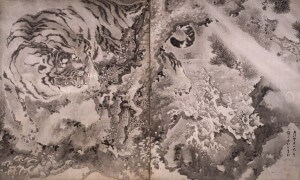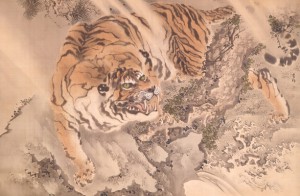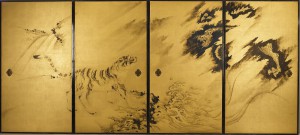Kishi School / Schools of Nihonga 008
Kishi School
Kishi School is a school in the Kyoto circle that existed from the late Edo period to the Meiji period. Its founder is Ganku. Kishi School competed with Maruyama School as a school of artists who painted pictures of objects they observed in front of them. The painting style of Ganku was inherited by his eldest son Gantai (1782-1865) and adopted child Ganryou (1797-1852). Among the many disciples of this school are such artists as Bumpou Kawamura, Kanzan Yokoyama and Kayou Shirai. Although Chikudou Kishi of the Meiji period pioneered a new style of painting based on modern perspectives, Kishi School was not blessed with good works and disappeared from the world of Japanese painting of the modern period.
Ganku
Ganku (1756 or 1749 – January 19, 1839) was a painter who lived in the Edo period. He was the patriarch of the Kishi-ha (the Kishi school).
Originally named Saeki Masaaki, the artist was born in the city of Kanazawa on Japan’s north coast in either 1749 or 1756, (records of his birth are in conflict). He moved to Kyoto in 1773 and became a retainer to Prince Arisugawa. In 1804 he entered the imperial court as an official and was appointed Echizen-no-Suke, honorary governor of Echizen Province. He again lived in Kanazawa from 1809 and finally settled in Iwakura outside Kyoto in 1813. In the same year he officially adopted the artist’s name Ganku Kishi. Initially, Ganku studied Kanou-style painting, but early in his studies he shifted to explore the Nanpin style named for the Chinese painter Shen Nanpin (active early 18th century). Following his study of Nanpin, he explored Japanese “naturalism” under Oukyo Maruyama and nanga-inspired “naturalism” under Goshun Matsumura of the Shijou school in Kyoto. Perhaps unsatisfied with any of these popular styles, he founded his own school, the Kishi school, characterized by a rough and vigorous brush style but still reflective of the many influences his training had provided.
Tiger Paintings of Ganku
Ganku is most well known as a painter of animals, in particular tigers. His works exhibit an almost Western-seeming solidity and are often filled with a sense of drama conveyed both by the subject matter and his muscular brushwork. He studied tigers through tiger’s bones, so that his tigers paintings were clearly different from conventional ones, which were depicted based on cats.





